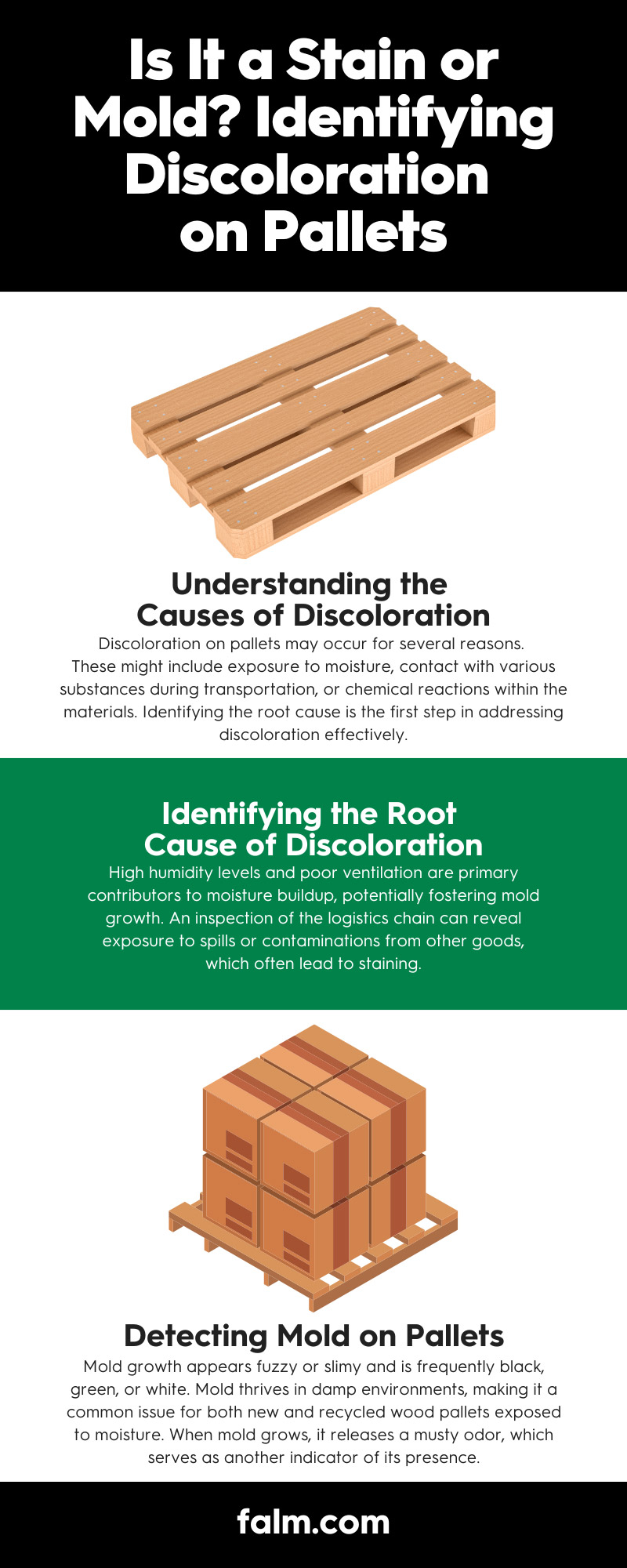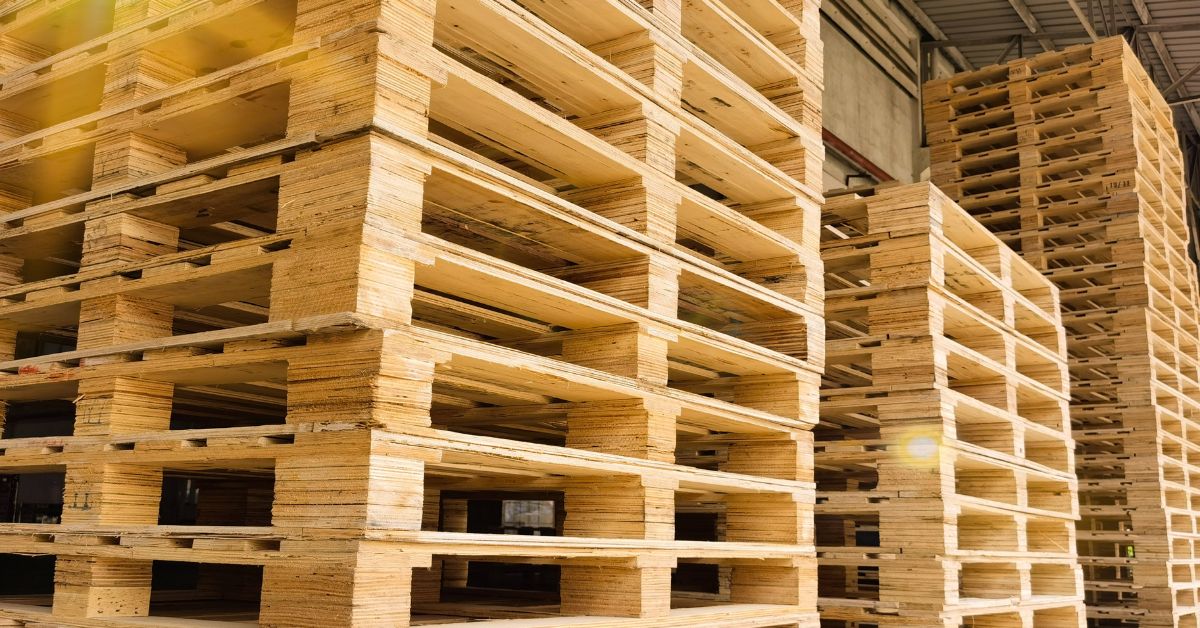Business owners and freight logistics managers often encounter the mystery of discoloration appearing on pallets. This discoloration can happen for various reasons, but stains and mold are the most common culprits.
Knowing the difference between the two is crucial for maintaining quality and safety standards in your supply chain. Let’s explore how to identify discoloration on pallets and handle these issues to keep your operations running smoothly.
Stains vs. Mold: The Key Differences
Stains usually result from an outside source, such as spills or contact with certain materials. These marks are typically superficial and don’t penetrate the wood deeply. Mold, on the other hand, thrives in damp and humid conditions and can penetrate the wood, leading to structural damage.
Characteristics of Stains and Mold
To further differentiate between stains and mold, investigate their unique characteristics. Stains often appear as colored blemishes, which can vary widely depending on the type of substance involved—ranging from dark oil marks to light water rings.
They tend to remain limited to the pallet’s surface and are usually non-threatening to the structural integrity of the wood. Warehouse employees can often remove stains with proper cleaning or light sanding.
In contrast, mold is a living organism and develops as a fuzzy or slimy texture, usually accompanied by an unmistakable musty odor. It can appear in a range of colors, including green, black, white, or gray.
Mold can compromise pallet strength as it infiltrates the wood’s fibers, potentially causing decay over time if left untreated. Its presence indicates excessive moisture, highlighting the need for diligent environmental control in storage or transport areas. These distinctions are essential for determining the appropriate steps for remediation and prevention.
Understanding the Causes of Discoloration
Discoloration on pallets may occur for several reasons. These might include exposure to moisture, contact with various substances during transportation, or chemical reactions within the materials. Identifying the root cause is the first step in addressing discoloration effectively.
Identifying the Root Cause of Discoloration
To effectively address discoloration on pallets, you must accurately identify the root cause. Start by examining the environmental conditions of your pallet storage and transportation systems.
High humidity levels and poor ventilation are primary contributors to moisture buildup, potentially fostering mold growth. An inspection of the logistics chain can reveal exposure to spills or contaminations from other goods, which often lead to staining.
Furthermore, consider the pallet material itself, as certain woods may react chemically with certain substances, leading to discoloration. A thorough investigation should include checking for timely maintenance and cleaning protocols to ensure that external factors are primarily responsible for the discoloration. Conducting moisture readings and chemical tests might also provide further insights, allowing for a targeted approach to correct the issue and prevent future occurrences.
Detecting Mold on Pallets
Mold growth appears fuzzy or slimy and is frequently black, green, or white. Mold thrives in damp environments, making it a common issue for both new and recycled wood pallets exposed to moisture. When mold grows, it releases a musty odor, which serves as another indicator of its presence.
The Impact of Mold on Pallets
Mold poses a significant threat to pallets and products they carry. Mold weakens the wood’s structure, leading to potential safety hazards during transport.
Additionally, it can contaminate goods, causing spoilage and financial loss. Addressing mold by taking swift action ensures the longevity and safety of your supply chain.
Steps for Determining the Presence of Mold
To accurately determine the presence of mold on pallets, conduct a comprehensive inspection that involves visual and sensory checks. First, scrutinize the pallets under adequate lighting to identify any discoloration or unusual markings. Pay special attention to any areas that appear fuzzy or slimy, as these are typical indicators of mold.
In addition to the visual cues, use your sense of smell to detect a musty or earthy odor, which mold often emits. If necessary, employ a moisture meter to assess the moisture content of the wood; elevated moisture levels could signify favorable conditions for mold growth.
For a more precise identification, consider using a swab test or sending samples to a laboratory for analysis, especially if the mold type needs investigating for safety compliance or remediation efforts. These methods can provide definitive evidence of mold presence, enabling you to take the necessary steps to mitigate and prevent further contamination.
Preventing Stains and Mold on Wood Pallets
Prevention begins with proper storage and handling of pallets. Keeping pallets in well-ventilated and dry areas minimizes the risk of mold growth.
Avoiding exposure to chemicals and other staining substances reduces the chances of discoloration. Implementing these practices prolongs the life of recycled wood pallets. Here are some other key practices that can affect the health, longevity, and appearance of your pallets:
Effective Cleaning Techniques
Cleaning techniques vary depending on whether the discoloration is a stain or mold. For stains, a simple cleaning solution with mild detergent and water usually suffices.
A more robust approach with mold-killing solutions like vinegar or commercial-grade cleaners is necessary for mold. Remember to thoroughly dry your pallets after cleaning to prevent further mold growth.
In cases where mold is already well-established, applying a mixture of bleach and water or hydrogen peroxide can effectively kill mold spores. Use these solutions with caution, wearing protective gloves and ensuring proper ventilation.
Apply these solutions generously to affected areas and allow them to sit for several minutes to penetrate and kill the mold. Once you’ve cleaned the pallet, rinsing it thoroughly with water and allowing it to dry completely in a well-ventilated area will help prevent mold from reoccurring.
Regular Inspection and Maintenance
Routine pallet inspection and maintenance are essential to prevent and manage discoloration issues. Business owners should establish a regular inspection schedule to identify potential problems early. Proper maintenance includes cleaning, repairing, and rotating pallets to extend their usability.
Incorporating advanced monitoring tools, such as moisture sensors or smart tags, can provide real-time data on environmental conditions, allowing for swift adjustments to prevent mold growth. Furthermore, creating a maintenance log can track a pallet’s full history, including past cleanings, repairs, and any identified issues, enhancing accountability and informing decision-making for future pallet procurement.
By adopting a proactive approach to inspection and maintenance, businesses can optimize their supply chain operations while safeguarding against potential safety hazards and financial losses associated with pallet discoloration.
Identifying discoloration on pallets and learning whether it’s a stain or mold is vital for maintaining product quality and safety. Proactive measures, such as proper storage, regular inspections, and effective cleaning, help business owners prevent these issues.
With careful attention, recycled wood pallets can continue to serve as reliable, cost-effective solutions for freight logistics. You can also tackle discoloration challenges by purchasing pallets from a trusted supplier, such as First Alliance Logistics Management. Our pallets are durable, less susceptible to mold, and will allow you to safeguard your supply chain’s integrity and efficiency. Visit our website today to learn more about our services!


